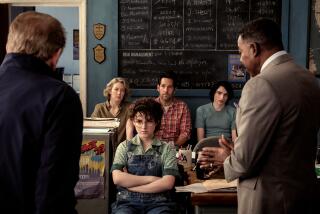Screening Series: Reminding audiences the Boxtrolls are real-world creations

“The Boxtrolls” director Anthony Stacchi, director Graham Annable and producer Travis Knight explain how working with their hands rewards them with a visceral connection.
The new film “The Boxtrolls” from Laika follows a young boy (voiced by Isaac Hempstead Wright) who is raised by an underground enclave of small trolls who live in boxes. He meets a girl (Elle Fanning) who helps him fight against a scheming exterminator (Ben Kingsley) out to rid their town of the Boxtrolls.
The film was recently shown as part of the Envelope Screening Series, with directors Anthony Stacchi and Graham Annable and producer and lead animator Travis Knight speaking at a Q&A.
In an era of computer animation, there is something special about the hand-done stop-motion techniques behind “The Boxtrolls.”
“Stop motion has been around for a long time, it was one of the first visual effects and is over a hundred years old,” said Knight. “Despite that, one of the things that I think that’s exciting as someone who loves stop motion, is it feels like we’re just scratching the surface of what you can do in the medium.”
As with Laika’s two previous features -- the Oscar-nominated “Coraline” and “ParaNorman” -- “The Boxtrolls” features some clips at the end which reveal a bit of the process of how the film was made. In a series of time-lapse shots, Knight can be seen manipulating two of the characters from the film, with a funny bit of dialogue by voice actors Nick Frost and Richard Ayoade.
“Now that we’ve done a few screenings, I know that audiences get lost in the story, lost in the movie and you totally and completely forget about the people and the process involved to actually make it,” said Annable. “So to get that little bit at the end is a fun way to have that reminder, ‘ Wow, there were fingertips involved every step of the way on this thing.’”
“When you look at the image, there’s something about the quality of the image, an intangible quality of the image, the fact that these are real objects, real fabrics, and they really exist and there is light on them,” added Stacchi. “It’s palpable in a way a CG film or a 2D drawn film isn’t. People have a visceral connection to the medium.”
Follow Mark Olsen on Twitter: @IndieFocus
More to Read
Only good movies
Get the Indie Focus newsletter, Mark Olsen's weekly guide to the world of cinema.
You may occasionally receive promotional content from the Los Angeles Times.







